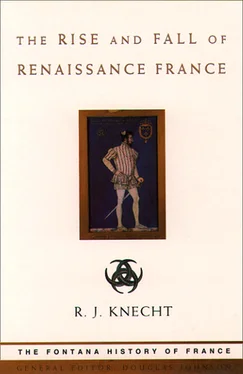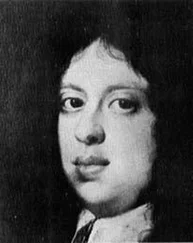On 15 January, Charles and the pope came to an agreement and next day the king knelt before the Vicar of Christ after attending mass at St Peter’s. On 20 January, Alexander celebrated mass in the basilica before the king and a congregation of 15,000 people. Among the cardinals present was the newly created Guillaume Briçonnet. The service lasted five hours, after which the pope blessed the French troops and gave them general absolution. Charles took his leave of the pope on 28 January. He had gained right of passage for his army through the States of the Church, but Alexander had not given him the investiture of Naples.
The French now resumed their southward advance. On 4 February they attacked the fortress of Monte San Giovanni. As the king wrote:
My cousin Montpensier had arrived before me with my artillery … and after firing for four hours my said artillery had made a breach wide enough for an assault. I ordered it to be made by men-at-arms and others, and though the place was held by 5–600 good fighting men as well as its inhabitants, they went in in such a manner that, thanks to God [the town] has been taken with little loss to me, and to the defenders great loss, punishment and great example to those others who might think of obstructing me.
As the French were entering the kingdom of Naples, its people rose in rebellion. King Alfonso fled to Sicily after abdicating in favour of his son Ferrandino, who, finding himself abandoned by most of his followers, shut himself up in the Castel Nuovo in Naples. On 19 February the first French troops entered the city. Soon afterwards Ferrandino accepted the offer of honourable retirement in France.
Charles VIII had improved on Caesar’s achievement for, as Guicciardini wrote, the king had conquered even before he had seen. This he owed largely to the reputation which had preceded him, clearing obstacles from his path. Without exception every town on his march south had opened its gates to him, making possible the spanking pace of his progress. In the words of Marsilio Ficino, Charles ‘had shaken the world by a nod of his head’. Chroniclers were dumbfounded by the effortlessness of his victory. One remarked that he had conquered Naples with a falcon on his wrist. Some contemporaries looked for rational explanations of his triumph; others just called it a miracle.
The king’s first task was to reward all the people who had assisted him in his campaign. They were showered with offices and lands. Eleven Frenchmen and only one Neapolitan were appointed to the council of state ( sacro consilio ). Frenchmen also acquired the principal offices of state, the only notable exceptions being the prince of Salerno and Giacomo Caracciolo, who recovered their offices of admiral and chancellor respectively. The governorships of provinces and towns were distributed in the same way. Etienne de Vesc, one of the main promoters of the Neapolitan expedition, acquired a veritable principality: he became duke of Nola and Ascoli, count of Avellino, great chamberlain and president of the Sommaria or chamber of accounts. The Colonna family was rewarded with dozens of fiefs. Several profitable marriages were also concluded between French noblemen and Neapolitan heiresses. Thus Louis de Luxembourg married Eleonora de Guevara, whose lands in Apulia yielded an annual income of 30,000 to 40,000 ducats, and Pierre de Rohan, marshal de Gié, married Eleonora’s younger sister.
However, the French conquest of Naples was not acceptable in the long term to other Italian states. In March 1495, as the king of France and his troops were enjoying the pleasures, reputable and disreputable, of Naples, four states – Milan, Venice, the papacy and Mantua – formed a league aimed at their expulsion from the peninsula. They planned to sever Charles’s communications with France. The king’s position was made all the more critical by the material aid promised to the league by Maximilian (who had succeeded as emperor in 1493) and King Ferdinand of Aragon. Maximilian recalled that the French expedition had been intended as a crusade, not a conquest, while Ferdinand argued that Charles had broken the Treaty of Barcelona. The league was the beginning of official interference by Spain in Italian affairs and more generally of foreign domination of the peninsula; it soon reached out beyond Italy, becoming a European coalition. Not all the Italian states joined the league. Florence and Ferrara abstained, and the hostility that divided the latter from Venice showed that the league could not eradicate internal rivalries. In spite of the challenge posed by the French conquest of Naples, Italian politics continued to focus on local interests. However, contemporary historians and chroniclers argued that the Italian states needed to work more closely together. As from 1494 the political outlook of many Italians, notably Machiavelli, was not entirely devoid of a certain national consciousness.
Charles wisely decided not to linger in his southern kingdom but to return home as quickly as possible. He divided his army into two parts: one to defend Naples under Gilbert de Montpensier as viceroy, the other to escort him back to France. On 20 May, Charles left Naples and travelled to Rome in only ten days. To avoid meeting him the pope retired first to Orvieto, then to Perugia. Meanwhile, in northern Italy, Louis d’Orléans, acting on his own authority, pre-empted a move by Lodovico Sforza against Asti by attacking the Milanese town of Novara. As this was an imperial fief, Louis’s move offered Maximilian a legitimate pretext for armed intervention. Charles, much alarmed by this turn of events, asked Pierre de Bourbon to send reinforcements in haste to Asti. Meanwhile, the king continued his march northward: he was at Siena on 13 June and at Pisa on the 20th, having by-passed Florence. While part of his army moved on Genoa, the bulk crossed the Appenines. Waiting for them on the north side was the league’s much larger army commanded by the marquis of Mantua. Charles was inclined to seek terms for a free passage, but Marshal Trivulzio argued successfully in favour of engaging the enemy. On 6 July the armies collided at Fornovo during a thunderstorm. Charles was nearly captured several times in the course of the battle which was extremely bloody, especially for the league. The marquis of Mantua claimed it as a victory, but it was really a draw; the French got through, admittedly with the loss of much baggage.
After covering 200 kilometres in seven days, Charles reached Asti on 15 July. Although annoyed with his cousin Louis for his unauthorized attack on Novara, he went to his assistance early in September. As he marched on Vercelli, the league opened talks which ended in a treaty (9 October): Novara was handed back to Milan, Orléans kept Asti, and Genoa was ‘neutralized’, though the French were still allowed to use its harbour facilities. Even more important, however, was Lodovico’s decision to abandon the league which promptly fell apart. On 15 October the situation in north Italy was sufficiently settled for Charles to undertake his homeward journey across the Alps.
Meanwhile, in the kingdom of Naples, the French under Montpensier found themselves subjected to mounting pressure as the Venetians attacked several towns along the Adriatic coast, and Ferrandino reoccupied Naples itself and laid siege to a number of fortresses within the city. Charles sent a fleet to Naples, but it was scattered by storms and never reached its destination. On 5 October, Montpensier signed a truce which prepared for his capitulation on 2 December unless he received help by that date. When it failed to materialize, several French garrisons surrendered. Gaeta and a few strongholds in Apulia held out longer, but they gradually fell to Ferrandino. Charles VIII clung to his rights in the kingdom, but the death of his infant son, Charles-Orland, prevented him from leading a rescue operation, for the king was traditionally bound to stay at home as long as his succession was not assured. He was also short of money. Even so, he spent the spring of 1496 in Lyon trying to organize two expeditions: one to relieve Montpensier, who was besieged in Atella, the other to defend Asti against attack by the duke of Milan. Early in 1498, Charles managed to win over his erstwhile opponent, the marquis of Mantua; but the king died on 7 April, before he was able to send a new expedition to Italy.
Читать дальше












